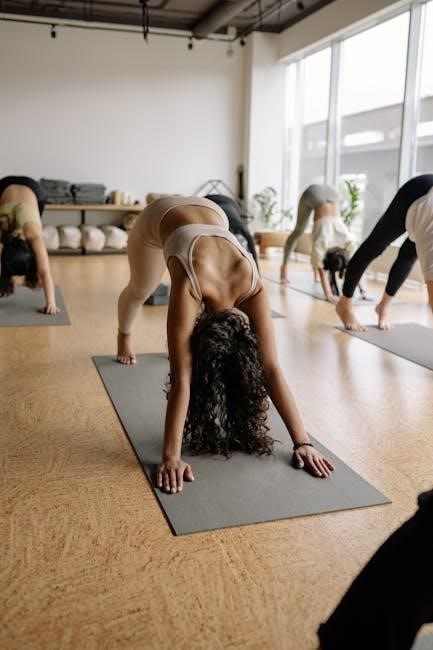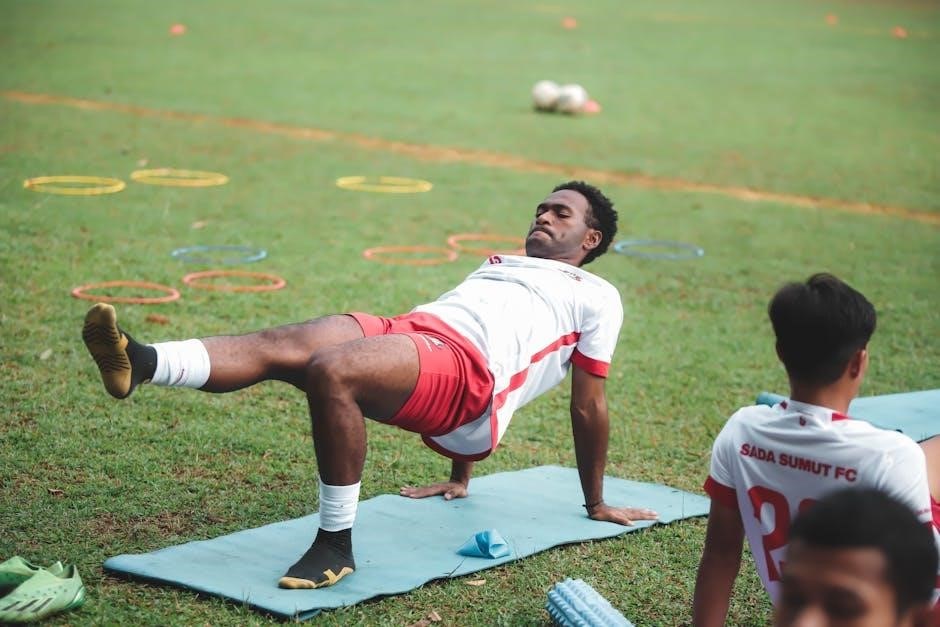Understanding the Psoas Muscle and Its Importance
The psoas muscle is a deep-seated, long muscle connecting the lumbar spine to the femur, playing a crucial role in hip flexion and lower back stability. Its tightness can lead to lower back pain and limited mobility, making stretching essential for relief and improved movement.
Functional Anatomy of the Psoas Major
The psoas major muscle is a long, deep-seated muscle located in the abdominal cavity, originating from the transverse processes of the lumbar vertebrae (L1-L5) and inserting into the lesser trochanter of the femur. It plays a vital role in hip flexion, lumbar stabilization, and posture maintenance. The psoas major works synergistically with the iliacus muscle to form the iliopsoas, which is the primary hip flexor. Its unique position allows it to influence both the lower back and the hips, making it a key player in movements such as walking, running, and sitting. Tightness or imbalances in the psoas major can lead to lower back pain, poor posture, and limited hip mobility. Understanding its functional anatomy is crucial for developing effective stretching and strengthening exercises to maintain optimal muscle function and overall mobility. Proper engagement and stretching of the psoas major can significantly improve flexibility and reduce the risk of injury.

Benefits of Psoas Stretching
Regular psoas stretching effectively alleviates lower back pain, enhances flexibility, and improves hip mobility. It reduces muscle tension, promotes better posture, prevents injuries, and boosts overall physical performance and well-being.
Relieving Lower Back Pain and Improving Mobility
Stretching the psoas muscle is highly effective in alleviating lower back pain, as tightness in this muscle often radiates discomfort to the lumbar region. By releasing tension in the psoas, individuals can experience significant pain relief and improved spinal alignment. Regular stretching enhances hip flexor mobility, allowing for smoother movement and reducing stiffness. This is particularly beneficial for those with sedentary lifestyles or athletes who engage in repetitive hip flexion movements. Improved mobility also promotes better posture, as the psoas plays a role in maintaining the natural curvature of the lower back. Additionally, stretching can prevent muscle imbalances that often lead to chronic pain and limited range of motion. Incorporating psoas stretches into a daily routine can lead to long-term benefits, including enhanced physical performance and a reduction in the risk of injuries related to tight hip flexors.

Effective Psoas Stretching Exercises
Regular psoas stretching is essential to prevent tightness and improve mobility. Effective exercises include kneeling, standing, and supine stretches, which target the muscle’s deep fibers, promoting flexibility and reducing lower back discomfort.
Kneeling Psoas Stretch
The kneeling psoas stretch is a highly effective exercise for targeting the iliopsoas muscle, which includes the psoas major and iliacus. To perform this stretch, start by kneeling on one leg with the other foot in front of you, forming a 90-degree angle. Ensure your front knee is directly above your ankle and your back knee is supported with a towel or cushion for comfort. Squeeze your glutes and gently push your hips forward to feel the stretch in the front of your back leg. For a deeper stretch, extend the same-side arm overhead and lean slightly to the opposite side. Hold the stretch for 20-30 seconds and repeat on the other side. This exercise is particularly beneficial for alleviating lower back pain and improving hip mobility. Focus on controlled, deep breathing to enhance the stretch and avoid any sudden movements. Regular practice of this stretch can significantly reduce tightness in the psoas muscle and improve overall flexibility;
Standing Psoas Stretch

The standing psoas stretch is an excellent way to target the psoas muscle while maintaining upright posture. To perform this stretch, stand with your feet shoulder-width apart and engage your core. Shift your weight onto one leg, keeping the other foot flexed and slightly behind you. Slowly lift the arm opposite to the back leg overhead and lean gently to the opposite side. This will create a stretch along the front of your hip and lower back. Hold for 20-30 seconds and switch sides. Ensure your movements are controlled and avoid bouncing. This stretch is particularly beneficial for individuals with tight hip flexors and can help improve balance and reduce lower back discomfort. Regular practice of the standing psoas stretch can enhance flexibility and promote proper alignment of the pelvis and spine. It’s a simple yet effective exercise that can be incorporated into daily routines for overall musculoskeletal health. Consistency is key to achieving lasting results and preventing muscle tightness.
Supine Psoas Stretch
The supine psoas stretch is a gentle and effective way to release tension in the psoas muscle while lying on your back. Begin by placing a foam roller or yoga block under your sacrum for support. Bend both knees and pull them toward your chest, holding onto one knee with each hand. Let go of one knee, straighten the leg, and allow it to drop toward the floor. This will create a stretch along the front of your hip and lower back. Hold for 20-30 seconds and then switch legs. To enhance the stretch, gently rock your pelvis back and forth or side to side. This exercise is particularly beneficial for individuals who spend a lot of time sitting or have tight hip flexors. The supine psoas stretch promotes relaxation, improves hip mobility, and can help alleviate lower back discomfort. Regular practice can lead to better posture and reduced muscle imbalances. It’s a low-impact exercise suitable for all fitness levels, making it an ideal addition to daily stretching routines.

Strengthening Exercises for the Psoas Muscle
Strengthening the psoas muscle enhances hip flexion, posture, and lower back stability. Pelvic tilts and core engagements are key exercises to activate and fortify the psoas, reducing lower back pain and improving overall mobility.
Pelvic Tilts and Core Engagements
Pelvic tilts and core engagements are fundamental exercises for strengthening the psoas muscle. Start by lying on your back with knees bent and feet flat on the floor. Engage your core by drawing your navel towards your spine. Slowly tilt your pelvis upwards, flattening your lower back against the floor, and then return to the starting position. This movement targets the psoas, improving its strength and flexibility. For added intensity, incorporate leg lifts while maintaining core stability. These exercises not only strengthen the psoas but also enhance lower back support and overall pelvic alignment. Regular practice can help alleviate lower back pain and improve posture; It’s important to perform these movements slowly and controlled to maximize effectiveness and prevent strain. Over time, incorporating pelvic tilts and core engagements into your routine can lead to significant improvements in psoas function and overall mobility. Consistency is key for optimal results.

Incorporating Yoga Poses for Psoas Release
Yoga offers effective poses to release tension in the psoas muscle, enhancing flexibility and reducing discomfort. One of the most beneficial poses is the Cobra Pose (Bhujangasana), which gently stretches the hip flexors and strengthens the lower back. Another powerful pose is the Pigeon Pose (Eka Pada Rajakapotasana), targeting the deep hip flexors and relieving tightness in the psoas. The Seated Forward Bend (Paschimottanasana) is also excellent, as it stretches the entire back side of the body, including the psoas, promoting relaxation and flexibility.
- Cobra Pose: Opens the chest and hips, relieving psoas tension.
- Pigeon Pose: Targets hip flexors and psoas, improving mobility.
- Seated Forward Bend: Stretches the lower back and hips, aiding in psoas release.
Regular practice of these yoga poses can significantly reduce psoas-related discomfort and enhance overall well-being.



